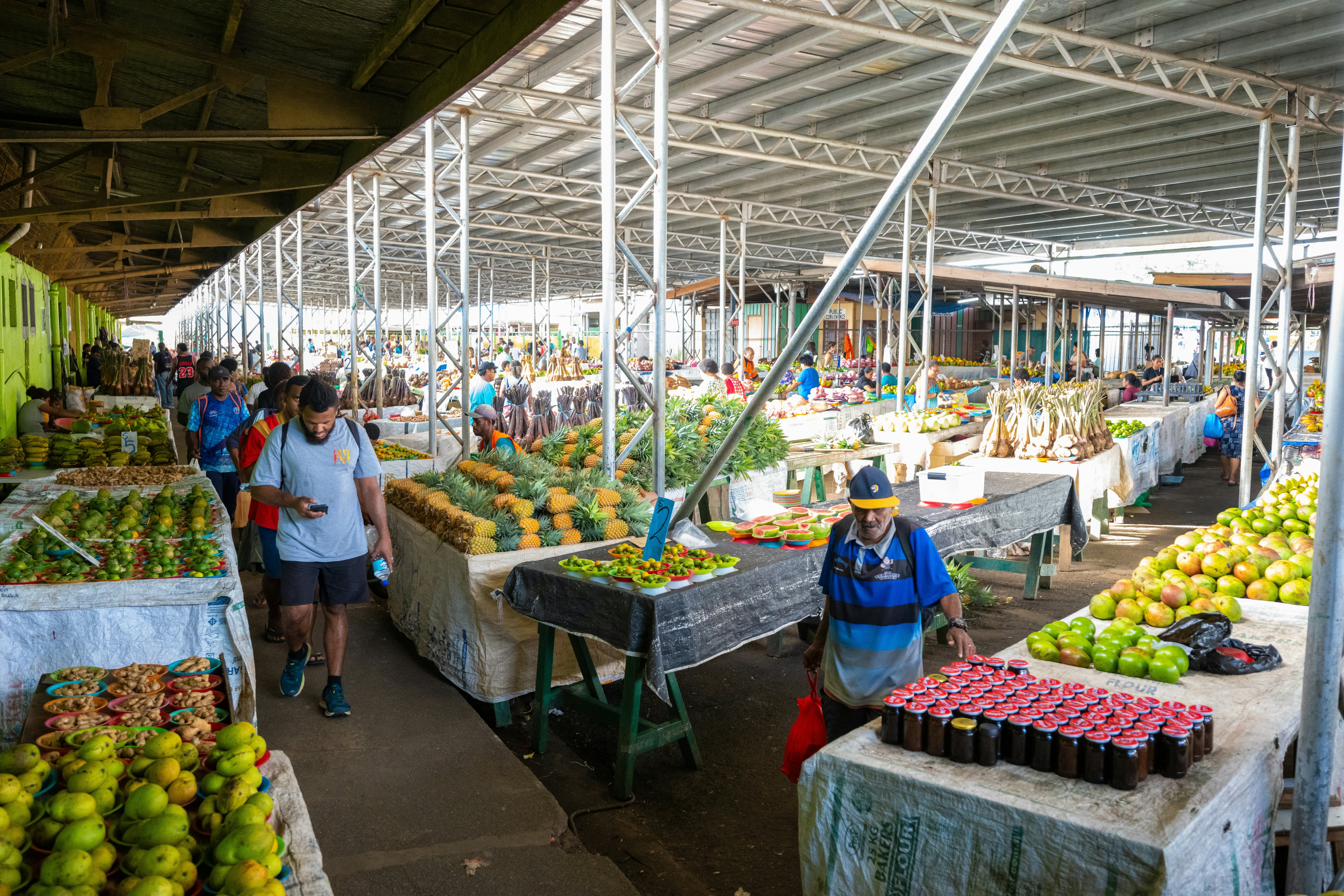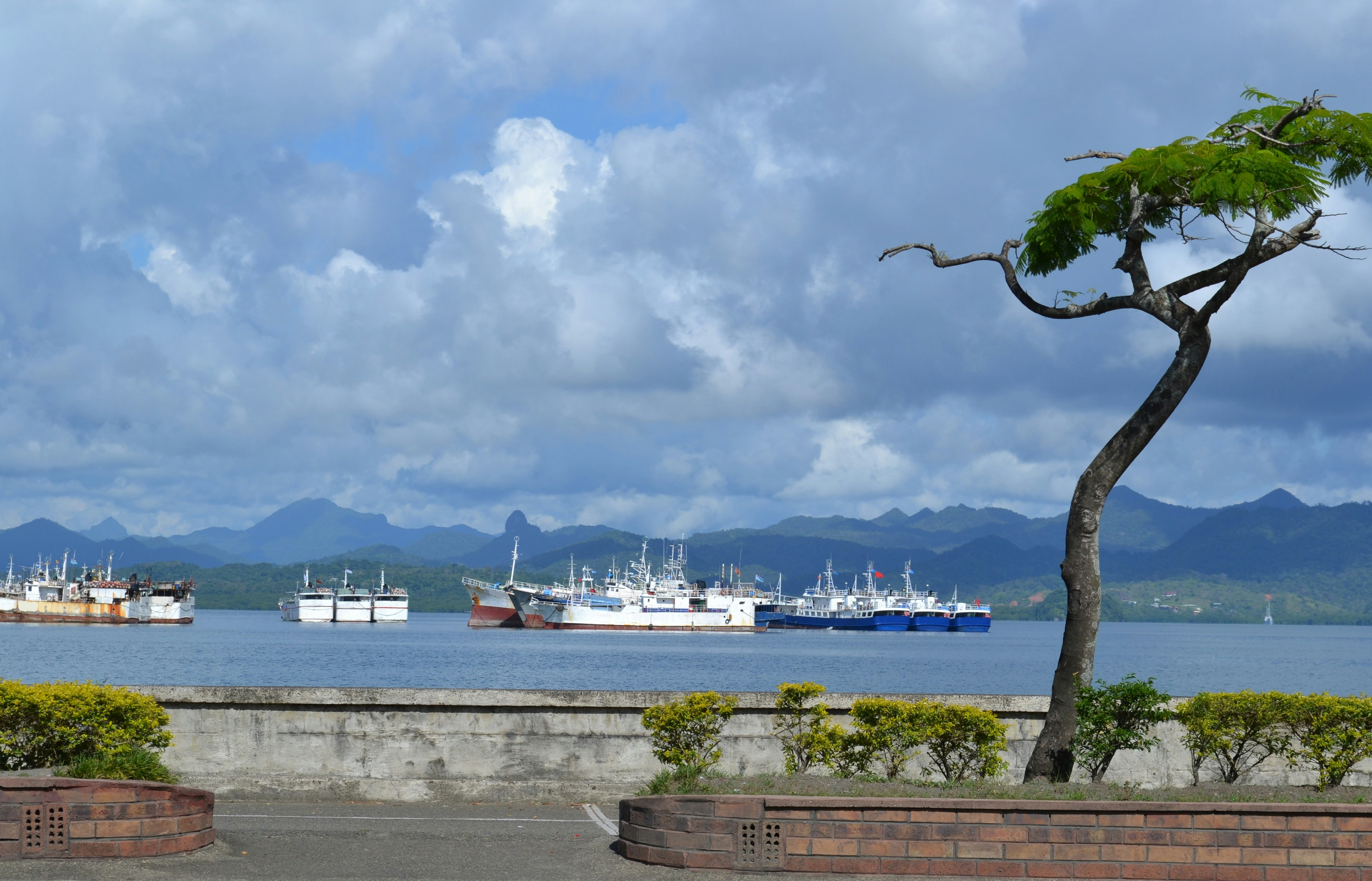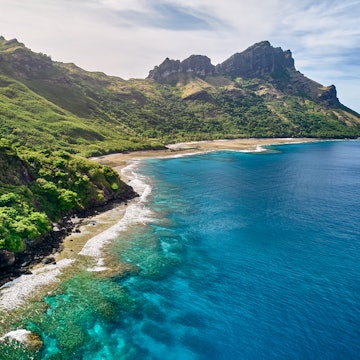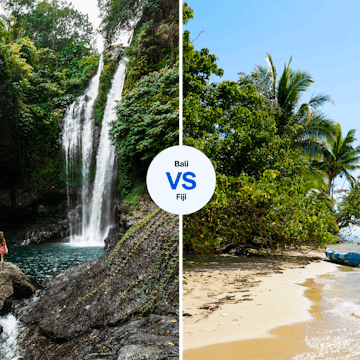

From artifacts highlighting connections to the sea to a grand hotel, here are the top things to do in Fiji’s capital. Dmytro Cherkasov/500px
Away from the typical tourist path, Suva gives visitors a genuine taste of everyday life in Fiji’s capital. When there’s no cruise ship in town, you might even be mistaken for a resident. What Fiji’s largest city lacks in white-sand beaches, it more than makes up for with cultural experiences, flavorful Indo-Fijian and traditional Fijian cuisine, and a warm, welcoming atmosphere for curious travelers. The compact city centre is easy to explore on foot, and you can see the main sights in just a few hours. If you’ve got extra time, nearby waterfalls, natural swimming holes, and uninhabited islets offer more to your itinerary.
After eight years of living in Suva, these are the places I always take visitors and often return to. In fact, this article was drafted at the Fiji Museum cafe and finished at the Grand Pacific Hotel (more on both below).

1. Suva Municipal Market
Best for seeing a snapshot of everyday Suva life
Suva’s largest market is where much of the city shops for fresh produce and daily goods. Outside, vendors sell Indian sweets, pineapples carved like lollipops, roti parcels filled with curry, fern salads, and baked treats that fuel locals during their workday. Inside, the ground floor brims with neatly stacked piles of fruits and vegetables, along with handmade coconut oils, soaps, intricate floral bouquets and woven goods. Upstairs, you’ll find barrels of aromatic spices and the essentials to make kava, where dried pepper root is ground into a fine powder and mixed with water for a relaxing drink.
Local tip: Early mornings are the liveliest time and best for picking fresh produce. However, if you’re walking around Suva, consider you’ll need to carry whatever you buy, and it might be best to circle back or visit the market later in the day, when it tends to be quieter.

2. The Fiji Museum and Thurston Gardens
Best for history (and horticulture) buffs
The Fiji Museum, the country’s largest collection of artifacts, highlights the islands’ deep connection to the sea. Its centerpiece is Ratu Finau, a double-hulled canoe (drua) built in 1914 as a faithful replica of Fiji’s traditional ocean-going vessels. Learn about Fiji’s early history through ancient Lapita pottery, how climate change is impacting the islands, and the tumultuous legacy of indentured servitude, when more than 60,000 Indians were brought to Fiji by the British in the late 19th and early 20th centuries as laborers. After your visit, stroll between the leafy Tahitian chestnut trees at neighbouring Thurston Gardens, which also happens to be home to hundreds of fruit bats who hang out in the upper branches.
Local tip: Allow around an hour and a half to explore the museum. The museum gift shop is an excellent place to find books about the South Pacific (Baka Books, 1km down the road from the museum, also has a wide selection). The small onsite café serves breakfast, lunch, smoothies and coffee.
3. The Sea Wall
Best for seaside walks
The four-kilometer coastal stretch rounding out the Suva peninsula from My Suva Park to Albert Park is an ideal path to stretch your legs. Along the way, you’ll pass mangrove forests and tidal flats where locals search for mud crabs, with views of Beqa Island visible on clear days. Around sunset, the walkway fills with Suva residents out for a stroll or jog, though some come to lounge on the seawall, swapping snacks and stories. Car enthusiasts park in perfect formation, gathering to show off and admire one another’s prized vehicles. The seawall at sunset is often lively, but not overwhelmingly so.
Local tip: The Sea Wall is one of the few places in Suva you can jog or walk without worrying about aggressive stray dogs. (The dogs along the sea wall are used to people.) Walk during high tide for a more pleasant experience – you’ll enjoy the sea breeze without the fishy low-tide smells. Time your stroll for sunrise or sunset to see the ocean glimmer in iridescent shades of pink.

4. Colo-i-Suva Forest Park
Best for rainforest swims
For an easy escape from the city, Colo-i-Suva (tholo-ee-soo-va), is just a 20-minute drive or bus ride from Suva’s city center, where you’ll be transported into a rainforest of mahogany, fern, pandanus, dakua and fruit trees. It feels like you might as well be in the island’s deepest interior. The park houses over a dozen species of endemic birds. Look for the fiery feathers of the orange dove or the scarlet robin. Barking imperial pigeons provide a soundtrack to the trail. On quiet days, kingfishers flit among the shallows. There’s a handful of trails weaving through the park, the most popular being a loop connecting a network of natural swimming pools – some with rope swings – and small waterfalls. During weekday school hours or early mornings, you may have the trail to yourself. Crowds come with the cruise ships, and Suva families take over the few picnic benches on Saturdays—but are typically happy to make space.
Local tip: The ranger station, where you pay the entry fee, is across the road from the park entrance. Phone signal is poor and petty theft occurs, so leave valuables behind. The upper and lower pools are the most accessible; beyond them, the path can get very slippery.
5. Albert Park
Best for Suva’s sports scene
Albert Park is Suva’s go-to spot for sports and socializing, a stretch of green near the city center. Joggers, walkers, families with prams and kids on bikes loop the park in counterclockwise direction. On the grass, rugby, soccer and cricket games unfold, with families and fans mingling along the sidelines. It’s a great spot for people-watching, and travelers are often welcomed into casual pick-up games. Suva landmarks like the Government Building, Courthouse, Grand Pacific Hotel and Fiji Museum border the park, making it an easy place to take in several of the city’s icons at once.
Local tip: Afterburn Fitness Fiji runs daily group workouts at Albert Park, with sessions for all fitness levels at 5am and 5:30pm. Time your visit for sunset to watch fruit bats take flight above the park.

6. Grand Pacific Hotel
Best for sunset drinks
On its surface, the Grand Pacific Hotel looks like a well-preserved emblem of colonial-era Fiji, though its walls reflect Fiji’s past century of history. It was built in 1914 to serve travelers transiting through the South Pacific, eventually elevating in status to host renowned artists, writers, celebrities and four generations of British royals. In the late 1990s, the hotel fell into disrepair, shuttered to tourists, and was used as a place to house soldiers during the coups that rocked Fiji’s early 2000s. Today, it’s resumed its status as a tourism treasure, catering to those looking for a five-star stay, though anyone can come and dine on fresh seafood, local beers and craft cocktails while watching the sunset over Suva Harbour.
Local tip: Check ahead to see if the hotel is offering any special events like high tea, art exhibits or cultural workshops during your trip.
7. Suva Handicraft Market
Best for souvenir shopping
Browse through any souvenir shop in Fiji, and you’ll find wooden carvings of warrior weapons, marine motifs and woven fans. Many travelers take these home as décor, hoping to bring a touch of Fiji with them. What many don’t realize is the macabre history behind some of these pieces – the multi-pronged fork was once a brain-eating utensil, and the y-shaped club was designed for breaking necks. These uses are not usually conveyed at the main shops of Fiji, where prices are high and products imported. At the Suva Handicraft Market, vendors happily share the history and meaning of each piece, and with a bit of negotiating, you’ll often be able to take them home for a lower price than you found in the shop.
Local tip: Visit the big stores like Jack’s or Tappoo to get a no-pressure anchor price point and overview of Fiji’s popular handicrafts before heading to the handicraft market. If a vendor offers to “gift” you a carving with your name on it, they’ll expect payment once it’s finished.
8. Royal Suva Yacht Club
Best for low-key lounging
Faded portraits and accolades on the walls of the Royal Suva Yacht Club speak of luxury from another lifetime, but it’s proudly unpretentious today – though you’ll have to take your hat off at the bar. The small yacht club houses everything from barely-floating boats to luxury catamarans, and is a popular spot among surfers, sailors and old salties who’ve commandeered the yacht club’s central table. Non-members are welcome anytime, but the place really comes alive on weekends when crowds gather for rugby matches and live music.
Local tip: Families are welcome at all hours – little ones usually form a pack and sprint around on the grass. Check the Facebook page for upcoming film festivals, holiday celebrations, fishing competitions and live music performances.

9. Suva Harbour
Best for ocean adventures
For those drawn to the water, Suva Harbour is an unassuming source of ocean adventures. A large barrier reef protects the city from strong swells and heavy surf, with only a narrow passage allowing ships into the harbor. Within the sheltered reef, you’ll find surprisingly healthy coral reefs to snorkel at, tiny islets to lounge on and a smattering of above-sea level shipwrecks perched on their sides. Rarely, humpback whales enter the harbor or are seen cruising out in the deeper blue. Suva Scuba, the city’s only dive center, based at the yacht club, runs trips to Suva reefs and a handful of the harbor’s 20+ shipwrecks. Reel Addiction Charters takes anglers offshore in search of big catches and families on leisurely day trips to nearby islets, like Sandbank and Nukulau.
Local tip: Suva holds the award of being the rainiest part of Fiji. Explore Suva Harbour during the sunniest day of your trip, saving the cultural activities if you run into wet weather. Pack a rain jacket for any boat rides, just in case.














